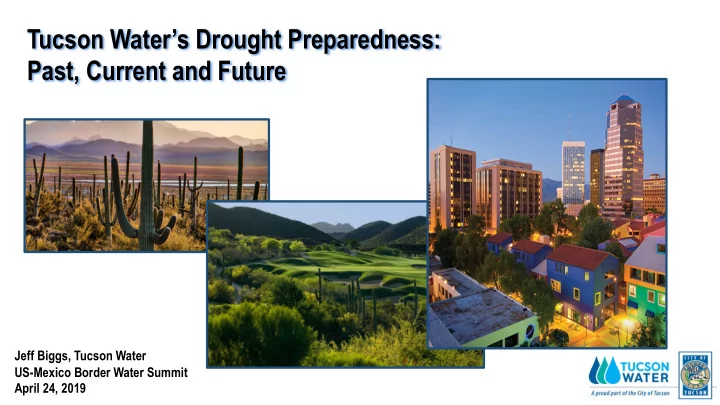

Tucson Water’s Drought Preparedness: Past, Current and Future Jeff Biggs, Tucson Water US-Mexico Border Water Summit April 24, 2019
Tucson Water Service Area Isolated • 730,000 customers Water Isolated Water System Systems Santa Catalina Mountains § Main potable system Avra Valley § Nine isolated systems Sandario Rd. Tucson Mountains § Reclaimed system Oracle Rd. • 35% of customers are outside the City Ci City of Speedway Blvd. Rincon Tucson Tu Mountains 22 nd St. Tohono O’Odham Nation limits Isolated Roskruge Mountains D D Water M M Houghton Rd. System A F A F B • 390 Square Miles T I A Avra Valley Ajo Highway Pascua Yaqui Tribe • Semi-arid climate Isolated Water Systems Tohono O’Odham Nation § Sonoran Desert § <12 inches/year rain City of Tucson Boundary Isolated Water Tucson Water Service Area System
Groundwater Water Resources Groundwater • Water stored in aquifer sediments Colorado River Water • Pumped from well fields Colorado River Water • Colorado River water delivered via the Remediated Water Central Arizona Project (CAP) canal • Recharge and Recovery Remediated Water Recycled Water • Contaminated groundwater, cleaned to Reclaimed Water drinking water or higher standards • TARP / AOP Recycled Water Rain/Stormwater • Direct use as reclaimed water • Recharged at various facilities Rain/Stormwater • Active systems • Passive systems
Water Production: 1940-2018 140,000 • Supply Diversification Water Production for TW Service Area (Acre-Feet) 120,000 • Supply Transition Rainwater Harvesting (Unmetered) 100,000 Groundwater • Conservation 80,000 60,000 CAP 40,000 20,000 TARP/AOP 0 Reclaimed Water 2018 2018 1940 1950 1960 1970 1980 1990 2000 2010 Year Groundwater CAP TARP Reclaimed Rainwater Harvesting (Unmetered)
Colorado River and Tucson Glen Canyon Rocky Mountains Dam R i v e r Hoover Dam o d a r o l o C Grand Canyon • City Of Tucson’s CAP Lake Santa Cruz River Havasu C e Allocation is 144,191 AF/YR n t r a l • Partner’s CAP Storage is Arizona 25,000 AF/YR Reservoir o c i x e M • Total 169,191 AF/YR o T Storage and Project Recovery Projects • Tucson Area’s Largest Renewable Supply Hayden/Udall WTP
Benefits of Recharge and Recovery • Soil aquifer treatment (SAT) to remove pathogens, suspended solids, and organics • Short- and long-term storage • Resiliency against outages on the delivery canal versus a surface water treatment plant • Multi-benefit facilities • Consistent water quality
Pathways to Resiliency • Conservation: Live within our means • Diversification: Optimize and expand supply • Banking: Store for the future (5 years stored) • Partnerships: Seek win-wins • Preparedness: Identify decision points and solutions • Quality: Monitor and protect water quality • Groundwater: Tucson’s “back-up plan” (30-40 years)
Water Level Declines Water Level Recovery 1940-1998 2000-2016
How is Tucson’s Water Situation
Recommend
More recommend